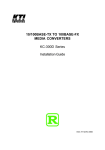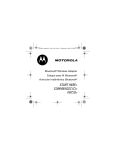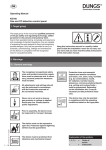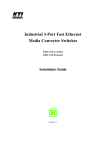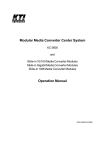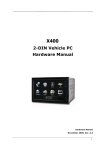Download KTI Networks KSC-240
Transcript
Industrial RS-232 to RS-485/422 Converter KSC-240 Installation Guide DOC.070412-KSC-240 -1- (C) 2006 KTI Networks Inc. All rights reserved. No part of this documentation may be reproduced in any form or by any means or used to make any directive work (such as translation or transformation) without permission from KTI Networks Inc. KTI Networks Inc. reserves the right to revise this documentation and to make changes in content from time to time without obligation on the part of KTI Networks Inc. to provide notification of such revision or change. For more information, contact: United States International KTI Networks Inc. P.O. BOX 631008 Houston, Texas 77263-1008 Phone: Fax: E-mail: URL: 713-2663891 713-2663893 [email protected] http://www.ktinet.com/ Fax: E-mail: URL: 886-2-26983873 [email protected] http://www.ktinet.com.tw/ -2- The information contained in this document is subject to change without prior notice. Copyright (C) All Rights Reserved. TRADEMARKS Ethernet is a registered trademark of Xerox Corp. FCC NOTICE This device complies with Class B Part 15 the FCC Rules. Operation is subject to the following two conditions: (1) This device may not cause harmful interference, and (2) this device must accept any interference received including the interference that may cause. CE NOTICE Marking by the symbol indicates compliance of this equipment to the EMC directive of the European Community. Such marking is indicative that this equipment meets or exceeds the following technical standards: EMC Class B EN 50081-1/1992 : EN55022:1994/A1:1995/A2:1997 Class B EN61000-3-2:2000 EN61000-3-3:1995/A1:2001 EN 55024:1998/A1:2001 IEC 61000-4-2:1995 IEC 61000-4-3:1995 IEC 61000-4-4:1995 IEC 61000-4-5:1995 IEC 61000-4-6:1996 IEC 61000-4-8:1993 IEC 61000-4-11:1994 -3- Table of Contents 1. Introduction ......................................................... 5 1.1 Features ........................................................................................ 6 1.2 Specifications ................................................................................ 7 2. Installation ......................................................... 12 2.1 Unpacking .................................................................................... 2.2 Safety Cautions .......................................................................... 2.3 DIN-Rail Mounting ....................................................................... 2.4 Panel Mounting ............................................................................ 2.5 Applying Power ........................................................................... 2.6 Power Failure Relay Output ........................................................ 2.7 DIP SW Configuration .................................................................. 2.7.1 RS-485/422 Driver and Receiver Control ................................. 2.8 Making Serial RS-232 Connection .............................................. 2.8.1 Cable for Connection to PC COM Port ..................................... 12 13 14 16 18 21 22 28 29 31 3 Making RS-485/422 Connection ....................... 32 3.1 3.2 3.3 3.4 3.5 3.6 RS-422 Point-to-Point Circuit ...................................................... RS-422 Multi-drop Network ......................................................... RS-485 Multi-drop Network ......................................................... RS-485 Half-duplex 2-wire Network ............................................ RS-485 Full-duplex 4-wire Network ............................................ Summary of the Converter Applications ...................................... 33 34 36 38 39 41 4 LED Indicators ................................................... 42 4.1 LED Indicators ............................................................................. 42 5 Factory Default Configuration .......................... 43 -4- 1. Introduction The industrial converter is designed to convert RS-232 signals to optically isolated, balanced, full or half-duplex RS-422 or RS-485 signals at baud rate up to 115.2Kbps. It features RTS control design, which allows software to control RS-485 transmission. With smart ADCTM (Auto Data Control) design, the converter can uses send data signal to control RS485 transmission automatically so no software control is required in RS485 mode. The Din-rail mountable design makes it ideal for industrial cabinets and enclosures. Further, more designs such as signal protection, wide operating temperature range, wide power voltage range are provided to suit for more industrial applications. For industrial environment, the converters are designed with the following enhanced features exceeding that of commercial media converters: • High and wide operating Temperature • Wide operating voltage range for DC power input • Power input interface: Industrial screw terminal block and DC power jack for external commercial power adapter as option • DIN rail mounting support for industrial enclosure • Screw panel mounting support for industrial enclosure • Industrial-rated Emission and Immunity performance -5- 1.1 Features Supports RS-232 baud rate up to 115.2Kbps Operation with no required configuration Provides surge protection (transient voltage) on all interface lines Provides high ESD protection on all line signals Optical isolated between RS-232 and RS-485/422 interfaces Supports RS-422, 2-wire RS-485, and 4-wire RS-485 network Supports full-duplex or half-duplex for RS-485/422 interface Provides remote RTS control for RS-485 transmission Provides ADC TM (Auto Data Control) for RS-485 transmission Designed for industrial environments with: - Surge, ESD, and isolation protection - DIN-rail and panel mounting support - Wide power voltage range support - Terminal block and Jack-type power connectors - Wide operating temperature range support - Alarm relay output for device power failure - Industrial-rated emission and immunity performance -6- 1.2 Specifications This figure shows the important components of the device: -7- Serial Interface (RS-232 Port) Connector DB9 female Pin Assignments DCE type Baud Rate Support Up to 115K baud Connector Shield Connect to chassis ground Connection Distance 15 meters High ESD Tolerance +/-15KV on Tx, Rx lines Overvoltage Protection Cutoff if over +/-28V Isolation Optical isolation with RS-485/422 interface RS-485/422 Interface Connector Signal Type Data Speed Standard High ESD Tolerance Overvoltage Protection Screw-type terminal block Balanced differential lines 115Kbps EIA-485, EIA-422 +/-15KV on driver and receiver lines Cutoff if over +/-28V LEDIndicators LED DISPLAY PWR Power status 232 TX 232 RX TXC STATE ON OFF RS-232 TX BLINK RS-232 RX BLINK RS-485/422 TX control ON OFF -8- INTERPRETATION Power on Power off RS-232 TX Activity RS-232 RX Activity RS-485 driver is enabled RS-485 driver is disabled Configuration DIP SW Settings SW Name State Function SW1-2&1 4W Off 4-wire (RS-485/422 driver receiver separated) 2W On 2-wire (RS-485/422 driver receiver connected) SW1-3 T -D T -E Off On Disable RS-485/422 receiver terminator Enable RS-485/422 receiver terminator SW1-4 TXC TXE Off On RS-485/422 driver enable control by RTS or ADC RS-485/422 driver is forced to enable SW1-5 RTS-D Off RTS-E On Disable RTS control for RS-485/422 TX RX Enable RTS control for RS-485/422 TX RX SW1-6 RXC RXE RS-485/422 receiver enable control by RTS or ADC RS-485/422 receiver is forced to enable. SW1-8&7 BIAS-D Off BIAS-E On RS-485/422 line bias is disabled RS-485/422 line bias is enabled SW2-1 SDD SDE Off On Disable ADC control for RS-485/422 TX RX Enable ADC control for RS-485/422 TX RX SW2-2 1200 On ADC Timing parameter for RS-232 baud 1200 SW2-3 2400 On ADC Timing parameter for RS-232 baud 2400 SW2-4 4800 On ADC Timing parameter for RS-232 baud 4800 SW2-5 9600 On ADC Timing parameter for RS-232 baud 9600 SW2-6 19200 On ADC Timing parameter for RS-232 baud 19200 SW2-7 38400 On ADC Timing parameter for RS-232 baud 38400 SW2-8 115200 On ADC Timing parameter for RS-232 baud 115200 Off On -9- DC Power Interface Interface Operating Input Voltages Power consumption Basic Information Conversion Optical Isolation Screw-type terminal block 1. Two pairs for power wire cascading 2. One pair for power failure relay output DC Jack (-D6.3mm/+D2.0mm) +7V ~ +30V(+5%) 0.6W @+7.5VDC, 12VDC, 30VDC input RS-232 RX data to RS-485/422 TX data RS-485/422 RX data to RS-232 TX data Isolated between RS-232 and RS-485/422 3000VDC rms Mechanical Dimension (base) Housing Mounting Support Weight W 28mm x D 82mm x H 95mm Enclosed metal with no fan DIN-rail mounting, Panel mounting 240g Environmental Operating Temperature Storage Temperature Relative Humidity -20oC ~ 70oC -20oC ~ 85oC 5% ~ 90% -10- Certificate FCC CE/EMC CE/LVD Safety Part 15 Class B EMI EN50081-1 Class B EMS EN55024 EN 60950 EN 50081-1/1992 : EN55022:1994/A1:1995/A2:1997 EN61000-3-2:2000 EN61000-3-3:1995/A1:2001 EN 55024:1998/A1:2001 IEC 61000-4-2:1995 ESD Test IEC 61000-4-3:1995 RS Test IEC 61000-4-4:1995 EFT/BURST Test IEC 61000-4-5:1995 Surge Test IEC 61000-4-6:1996 CS Test IEC 61000-4-8:1993 Magnetic Field IEC 61000-4-11:1994 Volatge Int. Dips -11- 2. Installation 2.1 Unpacking Check that the following components have been included: • Information CD • The device unit • DIN-rail mounting bracket If any item is found missing or damaged, please contact your local reseller for replacement. The following are available optional accessories: • Panel Mounting Bracket The bracket is used for mounting the device on a panel surface. • Commercial-rated AC power adapters: - Rated AC120V/60Hz DC7.5V 1A - Rated AC230V/50Hz DC7.5V 1A - Rated AC100V/50-60Hz DC7.5V 1A - Rated AC240V/50Hz DC7.5V 1A The adapters are used for supplying DC power to the converter via DC power jack interface. -12- 2.2 Safety Cautions To reduce the risk of bodily injury, electrical shock, fire, and damage to the equipment, observe the following precautions. • Do not service any product except as explained in your system documentation. • Opening or removing covers may expose you to electrical shock. Only a trained service technician should service components inside these compartments. • If any of the following conditions occur, unplug the product from the electrical outlet and replace the part or contact your trained service provider: - The power cable, extension cable, or plug is damaged. - An object has fallen into the product. - The product has been exposed to water. - The product has been dropped or damaged. - The product does not operate correctly when you follow the operating instructions. • Do not push any objects into the openings of your system. Doing so can cause fire or electric shock by shorting out interior components. • Operate the product only from the type of external power source indicated on the electrical ratings label. If you are not sure of the type of power source required, consult your service provider or local power company. -13- 2.3 DIN-Rail Mounting In the product package, a DIN-rail bracket is installed on the device for mounting the converter in a industrial DIN-rail enclosure. The steps to mount the device onto a DIN rail are: 1. Install the mounting bracket onto the device unit as shown below: 2. Attach bracket to the lower edge of the DIN rail and push the unit upward a little bit until the bracket can clamp on the upper edge of the DIN rail. 3. Clamp the unit to the DIN rail and make sure it is mounted securely. 4. Make sure that there are proper heat dissipation from and adequate ventilation around the device. -14- The final mechanical dimensions after installing DIN rail mounting bracket are: -15- 2.4 Panel Mounting The device is provided with an optional panel mounting bracket. The bracket support mounting the device on a plane surface securely. The mounting steps are: 1. Install the mounting bracket on the device unit. 2. Screw the bracket on the device unit. 3. Screw the device unit on a panel. 4. Make sure that there are proper heat dissipation from and adequate ventilation around the device. Do not place heavy objects on the device. -16- The screw locations and final dimension are shown below: -17- 2.5 Applying Power The power specifications of the device are: Operating Voltage +7 ~ +30VDC Power Consumption Max. 0.6W @+30VDC, +12VDC, +7.5VDC The device provides two types of power interfaces, terminal block and DC power jack for receiving DC power input from external power supply. Using Terminal Blocks Either DC1 interface or DC2 interface can be used to receive DC power from an external power system. Or, DC2 also can be used to deliver the power received on DC1 to next device in cascading way. DC1 + Vdc Positive (+) terminal DC1 - Vdc Negative (-) terminal DC2 + Vdc Positive (+) terminal DC2 - Vdc Negative (-) terminal Three 2P terminal plugs are provided together with the device. Two of the three plugs are used for DC1 and DC2 interfaces respectively. The plug is shown below: -18- Power wires: 24 ~ 12AWG (IEC 0.5~2.5mm2) Install the power source wires with the plug properly. Screw the wire with plug securely. Then, plug in DC1 contacts. If cascading the power to next device is needed, install the power wires and plug for another switch. Then, use DC2 contacts. Note: Only up to four device units can be cascaded to receive power from one main power input source. -19- Using DC Power Jack DC Jack Connector: Jack D 6.3mm D 2.0mm AC Power Adapters: Optional commercial rated adapters are available for purchasing. Rated AC120V/60Hz DC7.5V 1A Rated AC230V/50Hz DC7.5V 1A Rated AC100V/50-60Hz DC7.5V 1A Rated AC240V/50Hz DC7.5V 1A Connect power adapter DC plug to the DC power jack of the converter before connecting to the AC outlet. Connect the power adapter to the AC outlet. Note: Before you begin the installation, check the AC voltage of your area. The AC power adapter which is used to supply the DC power for the unit should have the AC voltage matching the commercial power voltage in your area. -20- 2.6 Power Failure Relay Output The device provides a relay output to report power failure event to a remote alarm monitoring system. The replay output is provided with two contacts labeled PF+ and PF- in the terminal block interface. Use the provided 2P terminal plug for signal wiring and plug into the PF+/ - contacts. The function is designed as : Power is normal PF+ contact is shorted with PF- contact. Power failure PF+ contact is disconnected with PF- contact. Note: Be sure the voltage applied on PF+/- contacts is within the specification of 30VDC/1A max. or 120VAC/0.5A max. -21- 2.7 DIP SW Configuration SW1-2 & 1 4W 4-wire (RS-485/422 driver receiver separated) 2W 2-wire (RS-485/422 driver receiver connected) [2W] setting activates the internal connection between driver and receiver in RS-485/422 interface. It simplifies the installation of the converter in a 2-wire bus. RS-422 usually uses 2-wire topology only. RS-485 supports both 2-wire and 4-wire topology. -22- SW1-3 T-D Disable RS-485/422 receiver terminator T-E Enable RS-485/422 receiver terminator [T-E] setting enables the internal 120 ohms terminator on the receiver interface. A proper termination is important in a bus topology or multidrop network. The terminator is a resistor added in parallel with the receiver's "A" and "B" lines in order to match the data line characteristic impedance and reduce signal reflection. This setting is useful when the converter is installed at the end of a RS-485 or RS-422 bus. If the internal 120 Ohm terminator is not appropriate for your application, use [T-D] to disable it and use external one. -23- SW1-4 TXC RS-485/422 driver enable control by RTS or ADC TXE RS-485/422 driver is forced to enable [TXC] setting enables RS-485/422 driver to be controlled by RTS method or ADC method. RTS method is described later. Refer to SW2 settings for more description about ADC method. [TXE] setting forces RS-485/422 driver to be enabled always. This setting is applied when Master function is required in an RS-485/RS-422 multidrop bus. -24- SW1-5 RTS-D RTS-E Disable RTS control for RS-485/422 driver Enable RTS control for RS-485/422 driver RTS control method allows the connected RS-232 device (such as a PC) to control RTS signal (CTS input at the converter end) by software to enable or disable RS-485/422 driver. [RTS-D] setting is used to disable RTS control method. SW1-6 RXC RS-485/422 receiver enable control by RTS or ADC RXE RS-485/422 receiver is forced to enable. [RXC] setting enable to use the same [TXC] logic but reverse it as RXC for the RS-485/422 receiver control. It means when the driver is enabled the receiver is disabled. The receiver is enabled when the driver is disabled. This setting is applied when a half-duplex communication is adopted. -25- SW1-8&7 BIAS-D RS-485/422 receiver line bias is disabled BIAS-E RS-485/422 receiver line bias is enabled The line bias is used to maintain the proper idle-state voltage to the idle condition (when no driver is enabled on the bus). These bias resistors are pull-up resistors on the data B line and pull-down resistors (to ground) on data A line. In 4-wire configuration, the bias resistors are placed on the receiver lines. [BIAS-D] disables the internal BIAS resistors on receiver lines. [BIAS-E] setting enables internal bias resistors. The bias configuration can support up to 30 receiver nodes with no terminators. If the bias configuration is not proper for your physical topology, set to [BIAS-D] and use external bias design according to your application. -26- SW2-1 SDD Disable ADC control for RS-485/422 driver SDE Enable ADC control for RS-485/422 driver ADC method involves special circuitry that senses when data is received on the RS-232 interface and is being transmitted and automatically enables the RS-485/422 driver as well as disabling the driver within one character length of the end of transmission. This is a useful method for driver control since it needs no software involved. In order to obtain an optimal performance, set SW2-2 ~ SW2-8 the associated timing parameter for each RS-232 baud rate. SW2-2 SW2-3 SW2-4 SW2-5 SW2-6 SW2-7 SW2-8 1200 2400 4800 9600 19200 38400 115200 ADC Timing parameter for RS-232 baud 1200 ADC Timing parameter for RS-232 baud 2400 ADC Timing parameter for RS-232 baud 4800 ADC Timing parameter for RS-232 baud 9600 ADC Timing parameter for RS-232 baud 19200 ADC Timing parameter for RS-232 baud 38400 ADC Timing parameter for RS-232 baud 115200 -27- 2.7.1 RS-485/422 Driver and Receiver Control The following table lists the possible DIP SW settings related to RS-485 and RS-422 driver and receiver control: SW1-4 TXE SW1-6 RXC SW1-5 RTS-D TXE RXE TXC RXE RTS-D SDD Driver is disabled. Receiver is enabled. TXC RXE RTS-E SDD Driver controlled by RTS Receiver is enabled. TXC RXC RTS-E SDD Driver controlled by RTS Receiver is enabled when driver is disabled. TXC RXE RTS-D SDE Driver controlled by ADC Receiver is enabled. TXC RXC RTS-D SDE Driver controlled by ADC Receiver is enabled when driver is disabled. - SW2-1 SDD - -28- Behavior Driver is enabled. Receiver is disabled. Driver is enabled. Receiver is enabled. 2.8 Making Serial RS-232 Connection Typical RS-232 Interface DCE Pin Assignment Table Pin# 1 2 3 4 5 6 7 8 9 Signal Name Input/Output Received Line Signal Detect Output TX Data Output RX Data Input DTE Ready Input Signal Ground Output DCE Ready Output Clear To Send Input Request To Send Output Ring Indicator Output -29- The RS-232 to RS-485/422 converter as an interface between an RS-232 device and RS-485 or RS-422 bus. The connection is illustrated as follows: The following signals received on the RS-232 interface are converted to RS-485 bus signals: Pin# 2 3 7 Signal Name TX Data RX Data Clear To Send Input/Output Output Input Input -30- 2.8.1 Cable for Connection to PC COM Port Connecting to 9-pin DTE device (Computer or PC COM) Connecting to 25-pin DTE device (Computer or PC COM) -31- 3 Making RS-485/422 Connection EIA-485 [TIA-485] Balanced (differential) interface; defines the Physical layer, signaling protocol is not defined. EIA-485 specifies bidirectional, half-duplex data transmission. Up to 32 transmitters and 32 receivers may be interconnected in any combination, including one driver and multiple receivers (multi-drop), or one receiver and multiple drivers. EIA/TIA-422 define a Balanced (differential) interface; specifying a single, unidirectional driver with multiple receivers (up to 32). RS-422 will support Point-to-Point, Multi-Drop topology, but not Multi-Point [EIA485]. EIA-485 devices may be used in 422 circuits, but EIA-422 may not be used in 485 circuits (because of the lack of an Enable line). The published TIA/EIA 485 and RS-422 standards define only the electrical characteristics of the drivers and receivers as listed below. They did not standardize such things such as cables and connectors, pinouts, bus arbitration, signaling protocols, or physical wiring topology. Many different implementations have come into use and they are often incompatible with each other. Characteristics Mode of operation RS-422 Differential Unidirectional Multipoint Allowed no. of Tx and Rx 1 Tx, 10 Rx Maximum cable length 4000ft length Maximum data rate 10Mbps Minimum Tx driver output range +/- 2V Maximum Tx driver output range +/- 5V Maximum Tx short-circuit current 150mA Tx load impedance 100 Rx input sensitivity +/- 200mV Maximum Rx input resistance 4k Rx input voltage range +/- 7V Rx logic high >200mV Rx logic low <200mV -32- RS-485 Differential Full Duplex Multipoint 32 Tx, 32 Rx 4000ft length 10Mbps +/- 1.5V +/- 5V 250mA 54 +/- 200mV 12k -7V to +12V >200mV <200mV RS-485 and RS-422 are in wide use as an interface for telecommunications, industrial, medical, security and networking applications. The following sections describe examples of some of popular physical topologies. 3.1 RS-422 Point-to-Point Circuit This is the simplest configuration, just one driver and one receiver. If termination is used, it is only required at the receiver. Most RS-422 cables used to connect telecom or data-com equipment are point to point links. The converter can convert an RS-232 device into a Driver node in this point-to-point circuit. The configuration is: SW1-4 SW1-6 SW1-5 SW2-1 TXE RXC RTS-D SDD Enable Driver always Enable Receiver RTS/ADC Control Disable RTS control Disable ADC control -33- It also can convert an RS-232 device into a receiver node in this point-topoint circuit. The configuration for a RECEIVER node is: SW1-4 SW1-6 SW1-5 SW2-1 TXC RXE RTS-D SDD Enable RTS/ADC Control for Driver Enable Receiver always Disable RTS control Disable ADC control 3.2 RS-422 Multi-drop Network In this topology there is only one driver sending to one or more receivers. One termination resistor is recommended at the extreme end of the bus to eliminate reflections. Up to 10 receivers are permitted under RS422. Multiple receive-only nodes may be used for point-to-multipoint communications. -34- The converter can convert an RS-232 device into a Master node in this multi-drop network. The configuration for MASTER node is: SW1-4 SW1-6 SW1-5 SW2-1 TXE RXC RTS-D SDD Enable Driver always Enable Receiver RTS/ADC Control Disable RTS control Disable ADC control It also can convert an RS-232 device into a SLAVE node in this multi-drop network. The configuration for a SLAVE node is: SW1-4 SW1-6 SW1-5 SW2-1 TXC RXE RTS-D SDD Enable RTS/ADC Control for Driver Enable Receiver always Disable RTS control Disable ADC control -35- 3.3 RS-485 Multi-drop Network This topology is similar to RS-422 multi-drop. However, up to 32 receivers are permitted under RS-485. This may be used for point-to-multipoint communications. The converter can convert an RS-232 device into a Master node in this multi-drop network as illustrated below: The configuration for MASTER node is: SW1-4 SW1-6 SW1-5 SW2-1 TXE RXC RTS-D SDD Enable Driver always Enable Receiver RTS/ADC Control Disable RTS control Disable ADC control -36- It is also able to convert an RS-232 device into a SLAVE node in this multidrop network. The configuration for a SLAVE node is: SW1-4 SW1-6 SW1-5 SW2-1 TXC RXE RTS-D SDD Enable RTS/ADC Control for Driver Enable Receiver always Disable RTS control Disable ADC control -37- 3.4 RS-485 Half-duplex 2-wire Network This is the typical RS-485 topology. It takes advantage of RS-485 capability to support multiple drivers on a bus. RS-422 devices should not be used in this configuration. This topology enables bidirectional communication from many nodes over long distances at low to medium data rates, all on a single pair of wires (2-wire). It can implement a very functional, very flexible and very economical data network. Because signals travel in both directions, this bus should be terminated at both ends to prevent reflections. Only one node can drive the bus at a time, making this a half-duplex communication channel. Only one driver should be active at any one time. Therefore the transceivers used on a half-duplex bus should support a Driver Enable function. -38- The converter features RS-485 driver and receiver in one device. It also provides very flexible configuration settings for Driver Enable control and Receiver Enable control. The configuration for the node in RS-485 2wire network is: SW1-2&1 SW1-4 SW1-6 SW1-5 SW2-1 SW2-2-8 SW1-3 2W TXC RXC RTS-E SDE Baud T-D Select 2-wire topology Enable RTS/ADC Control for Driver Enable RTS/ADC Control for Receiver Use RTS control (optional) Use ADC control (optional) Baud when ADC control is enabled (optional) Disable internal terminator (optional) 3.5 RS-485 Full-duplex 4-wire Network The 4-wire network simplifies bus arbitration in multi-node RS-485. A single Master node is the only driver allowed on the top most wire pair. All other nodes listen to all data traffic that passes on the party-line type multi-drop bus. Nodes may transmit on the lower pair of wires when addressed by the master node or by using a software token-passing bus arbitration scheme. -39- The master node may drive its bus while any of the slave nodes are driving the lower pair, making this 4-wire network a full-duplex communication channel. All communication occurs from master to slave or slave to master, so any peer to peer communications must be routed through the master node. To convert an RS-232 device into a Master node in RS-485 4-wire network, the configuration is: SW1-2&1 SW1-4 SW1-6 SW1-5 SW2-1 SW2-2-8 SW1-3 4W TXE RXC RTS-E SDE Baud T-D Select 4-wire topology Enable Driver always Enable RTS/ADC Control for Receiver Use RTS control (optional) Or use ADC control (optional) Baud when ADC control is enabled (optional) Disable internal terminator (optional) To convert an RS-232 device into a Slave node in RS-485 4-wire network, the configuration is: SW1-2&1 SW1-4 SW1-6 SW1-5 SW2-1 SW2-2-8 SW1-3 4W TXC RXE RTS-E SDE Baud T-D Select 4-wire topology Enable RTS/ADC Control for Driver Enable Receiver always Use RTS control (optional) Or use ADC control (optional) Baud when ADC control is enabled (optional) Disable internal terminator (optional) -40- 3.6 Summary of the Converter Applications The common topologies implemented with RS-485 and RS-422 are: 1. RS-422 point to point in 2 -wire circuit 2. RS-422 2-wire multi-drop network 3. RS-485 2-wire multi-drop network 4. RS-485 half-duplex bidirectional network in 2-wire topology 5. RS-485 full-duplex bidirectional network in 4-wire topology The converter is equipped with functionality and flexibility to convert an RS-232 device to a node in any one of the above topologies. -41- 4 LED Indicators The following figure shows the locations of the LED indicators: 4.1 LED Indicators LED PWR DISPLAY Power status STATE ON OFF INTERPRETATION The device is powered on. The device is powered off. 232 TX RS-232 TX ON OFF RS-232 TX data is present No RS-232 TX data 232 RX RS-232 RX ON OFF RS-232 RX data is present No RS-232 RX data TXC RS-485 Driver Enable ON OFF The driver is enabled. The driver is disabled and is in tri-state (high-impedance). -42- 5 Factory Default Configuration The following table lists the factory default settings for configuration DIP SW: SW Name SW1-2&1 4W Default Setting 4-wire (RS-485/422 driver receiver separated) SW1-3 T-D (Off) Disable RS-485/422 receiver terminator SW1-4 TXC (Off) RS-485/422 driver enable control by RTS or ADC SW1-5 RTS-D (Off) Disable RTS control for RS-485/422 driver SW1-6 RXC (Off) RS-485/422 receiver enable control by RTS or ADC SW1-8&7 BIAS-D (Off) Disable RS-485/422 line bias SW2-1 SDE (On) Enable ADC control for RS-485/422 driver SW2-2 Off Disable ADC Timing for RS-232 baud 1200 SW2-3 Off Disable ADC Timing for RS-232 baud 2400 SW2-4 Off Disable ADC Timing for RS-232 baud 4800 SW2-5 9600 (On) Select ADC Timing for RS-232 baud 9600 SW2-6 Off Disable ADC Timing for RS-232 baud 19200 SW2-7 Off Disable ADC Timing for RS-232 baud 38400 SW2-8 Off Disable ADC Timing for RS-232 baud 115200 -43-











































